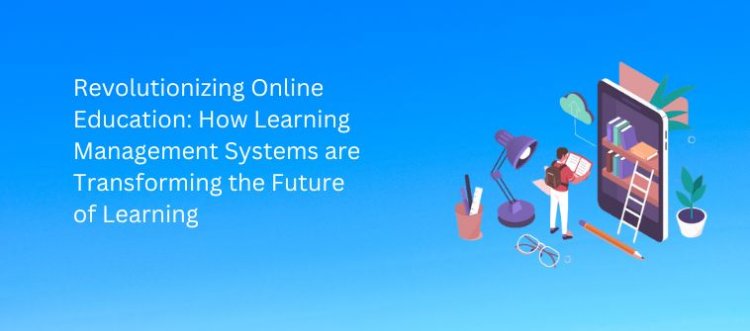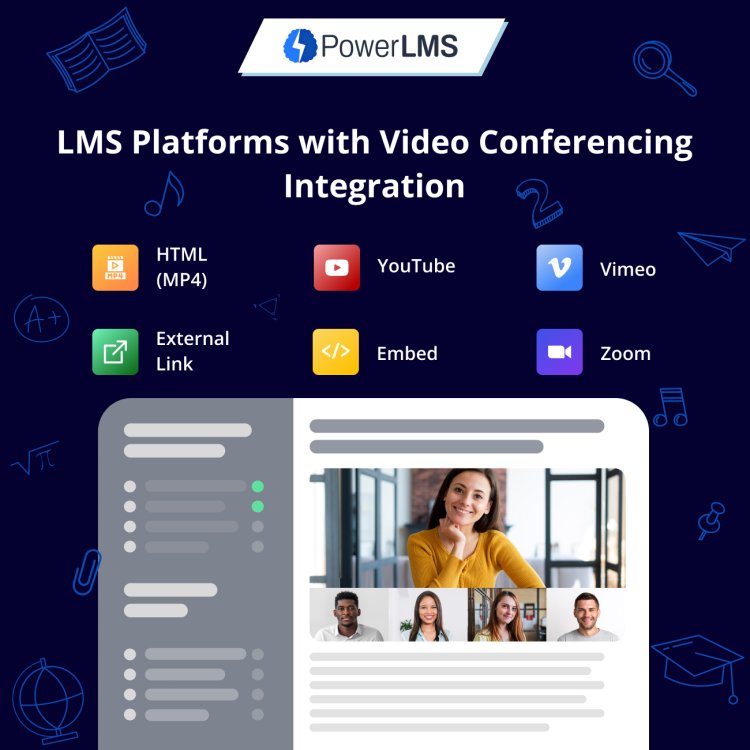Revolutionizing Online Education: How Learning Management Systems are Transforming the Future of Learning
Revolutionizing Online Education: How Learning Management Systems are Transforming the Future of Learning" is an article that explores the role of Learning Management Systems (LMS) in transforming the online education landscape. The article covers the basics of LMS, benefits of using an LMS for online education, top features to look for in an LMS, and tips for successful adoption and integration of an LMS. It highlights how LMS are enhancing accessibility, engagement, and efficiency in online education, and the importance of customization, analytics, collaboration tools, mobile compatibility, content creation tools, and integration in choosing the right LMS. The article concludes that LMS have the potential to revolutionize online education by creating a dynamic and engaging learning experience that meets the needs of learners in today's world.
Share this Post to earn Money ( Upto ₹100 per 1000 Views )
In the world of online education, a Learning Management System (LMS) is an essential tool that facilitates the delivery of digital learning content and manages the entire learning process. It is a software application that enables educators and trainers to create, deliver, and track online courses and training programs.
An LMS acts as a central hub for all online learning activities and provides a platform for students and instructors to access, manage, and interact with educational content. It typically includes features such as course authoring, content management, grading, reporting, and analytics.
One of the primary advantages of an LMS is its ability to offer flexible learning experiences that cater to the diverse needs of learners. For instance, an LMS can support different types of content formats, such as text, images, videos, and interactive quizzes. It can also accommodate various learning styles, such as visual, auditory, and kinesthetic.
Additionally, an LMS can foster communication and collaboration between learners and instructors, regardless of their physical location. This is particularly important in the context of online education, where students may be geographically dispersed and unable to attend physical classes. An LMS can provide tools for discussion forums, video conferencing, and chat rooms to facilitate online communication and interaction.
Finally, an LMS can provide valuable insights into learner performance and progress, which can inform the design and delivery of online courses. By tracking metrics such as completion rates, engagement levels, and assessment scores, instructors can evaluate the effectiveness of their teaching strategies and make data-driven decisions to improve learning outcomes.
Overall, an LMS is an indispensable tool for modern online education, offering a range of benefits for learners and instructors alike. By understanding the basics of an LMS, educators can leverage this technology to create engaging, effective, and scalable online learning experiences.
Benefits of Using an LMS for Online Education: Enhancing Accessibility, Engagement, and Efficiency
In the rapidly evolving landscape of online education, Learning Management Systems (LMS) have emerged as powerful tools for enhancing accessibility, engagement, and efficiency. Here are some of the key benefits of using an LMS in online education:
lAccessibility: One of the primary advantages of an LMS is that it enables learners to access educational content and resources anytime, anywhere. This is particularly important for students who have other commitments or who are unable to attend physical classes. An LMS allows students to learn at their own pace and on their own schedule, which can help to increase retention and engagement.
lEngagement: An LMS can offer a range of features that promote student engagement and interactivity. For instance, an LMS can include multimedia content, such as videos and interactive quizzes, which can help to make learning more engaging and memorable. Additionally, an LMS can support communication and collaboration between learners and instructors, through tools such as discussion forums and virtual classrooms.
lEfficiency: An LMS can streamline the delivery of educational content and reduce administrative overheads. For example, an LMS can automate the grading of assessments, which can save instructors time and effort. Additionally, an LMS can provide analytics and reporting features that enable instructors to track learner progress and identify areas for improvement.
lScalability: An LMS can support the delivery of educational content to a large number of learners simultaneously. This is particularly important for online courses, which can attract thousands of students from around the world. An LMS can handle the complexity of delivering educational content at scale, enabling instructors to reach a broader audience and maximize the impact of their teaching.
lCustomization: An LMS can be tailored to meet the specific needs of learners and instructors. For instance, an LMS can support different types of content formats, such as text, images, and videos, which can cater to different learning styles. Additionally, an LMS can be configured to reflect the branding and style of an educational institution, which can enhance the sense of community and belonging among learners.
Overall, the benefits of using an LMS for online education are clear. By enhancing accessibility, engagement, and efficiency, an LMS can help to deliver high-quality educational content to learners around the world, at scale. As such, an LMS is a powerful tool for realizing the potential of online education in the 21st century.
Top Features to Look for in an LMS: Customization, Analytics, and Collaboration Tools
hoosing the right Learning Management System (LMS) for online education can be a daunting task, with many options available on the market. To help educators make an informed decision, here are some of the top features to look for in an LMS:
lCustomization: An LMS should provide a high degree of customization, to enable educators to tailor the learning experience to the needs of their students. Customization features could include the ability to personalize the user interface, upload custom branding, and tailor the course content to specific learners or groups.
lAnalytics: An LMS should provide robust analytics and reporting tools, to enable educators to track student progress and measure the effectiveness of their teaching strategies. Analytics could include metrics such as completion rates, engagement levels, and assessment scores. These metrics can help educators to identify areas for improvement and optimize the learning experience.
lCollaboration Tools: An LMS should provide collaboration tools that enable learners to interact with each other and with the instructor. Collaboration tools could include discussion forums, chat rooms, video conferencing, and virtual classrooms. These tools can help to create a sense of community among learners and facilitate learning through social interaction.
lMobile Compatibility: An LMS should be mobile-friendly, to enable learners to access course content on-the-go. This is particularly important in today's world, where many learners access educational content through their smartphones or tablets. A mobile-compatible LMS should provide a responsive user interface, with content that is optimized for smaller screens.
lContent Creation Tools: An LMS should provide content creation tools that enable educators to create engaging and interactive learning content. Content creation tools could include drag-and-drop interfaces, multimedia support, and gamification features. These tools can help to create a dynamic and engaging learning experience that keeps students motivated and focused.
lIntegration: An LMS should integrate with other tools and platforms, to enable educators to leverage existing infrastructure and resources. For instance, an LMS should integrate with video conferencing tools, such as Zoom or Skype, to facilitate virtual classrooms. Additionally, an LMS should integrate with content creation tools, such as Articulate or Captivate, to enable educators to create multimedia content easily.
In conclusion, choosing the right LMS for online education requires careful consideration of features that enable customization, analytics, collaboration, mobile compatibility, content creation, and integration. By selecting an LMS with these features, educators can create a powerful and effective learning experience for their students.
Overcoming LMS Implementation Challenges: Tips for Successful Adoption and Integration in Online Education
Implementing a Learning Management System (LMS) in online education can be a complex and challenging process. Here are some tips for overcoming implementation challenges and ensuring successful adoption and integration of an LMS:
lEstablish Clear Goals: Before implementing an LMS, it is important to establish clear goals and objectives. This will help to ensure that the LMS is aligned with the needs of the organization and will enable educators to measure the success of the implementation.
lChoose the Right LMS: Choosing the right LMS is critical to the success of the implementation. Educators should consider factors such as customization options, analytics and reporting features, collaboration tools, mobile compatibility, and content creation tools when selecting an LMS.
lPlan for Implementation: Implementing an LMS requires careful planning and coordination. Educators should create a detailed implementation plan that outlines the steps required for successful adoption and integration. This should include timelines, roles and responsibilities, and contingency plans for any unforeseen challenges.
lProvide Adequate Training: Training is critical to ensuring successful adoption of an LMS. Educators should provide adequate training to staff and students to ensure that they are comfortable using the platform and can maximize its potential. Training could include tutorials, online resources, or in-person workshops.
lMonitor and Evaluate Progress: Monitoring and evaluating progress is important to ensure that the implementation is meeting its goals and objectives. This could include tracking metrics such as adoption rates, engagement levels, and student performance. Educators should use this information to make adjustments and improvements as needed.
lAddress Technical Issues: Technical issues can be a major challenge when implementing an LMS. Educators should have a plan in place to address technical issues as they arise, such as providing technical support to users or having a dedicated IT team to troubleshoot problems.
lCommunicate and Engage: Communicating and engaging with stakeholders is critical to ensuring successful adoption and integration of an LMS. Educators should communicate the benefits of the LMS to staff and students, solicit feedback and suggestions, and create a sense of ownership and investment in the platform.
In conclusion, implementing an LMS in online education requires careful planning, coordination, and collaboration. By establishing clear goals, choosing the right LMS, providing adequate training, monitoring progress, addressing technical issues, and communicating and engaging with stakeholders, educators can overcome implementation challenges and ensure successful adoption and integration of an LMS.

















